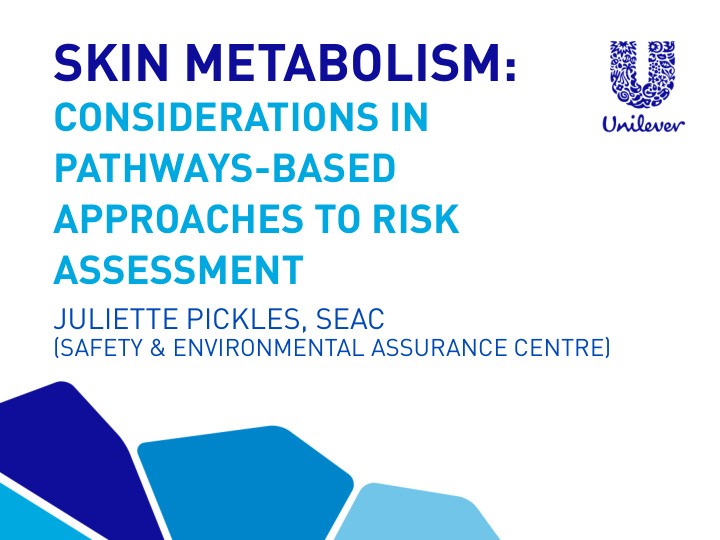



SKIN METABOLISM: CONSIDERATIONS IN PATHWAYS-BASED APPROACHES TO RISK ASSESSMENT JULIETTE PICKLES, SEAC (SAFETY & ENVIRONMENTAL ASSURANCE CENTRE)
CONSUMER SAFETY • In assessing safety risks to our consumers, we must consider both exposure and potential toxicity of ingredients. • For home and personal care products, dermal absorption is the major exposure route. • Metabolism of a parent ingredient in the skin may increase or decrease toxicity and bioavailability. SEAC
HUMAN HEALTH RISK ASSESSMENT Hazard Exposure Risk ? X Historical Non-animal We assess risk to prevent adverse events in consumers What risk does ingredient X at conc. Y in product Z pose Product to the consumer? To do so we require: Exposure data – product-relevant consumer exposure scenario Hazard characterisation data – dose response information on potency SEAC
TRADITIONAL HUMAN HEALTH RISK ASSESSMENT FOR CHEMICAL INGREDIENTS NOAEL No Observed Adverse Effect Level (NOAEL) ÷ 10 - 1000
TRADITIONAL HUMAN HEALTH RISK ASSESSMENT • Benefits: Complete living system. Aspects such as metabolism are “built in”. • Problems: Ethics, human relevance, black box approach. • Drivers for change • Drive for better, human-relevant mechanistic understanding in safety assessment ('Toxicity Testing in the 21st Century' (NRC, 2007), 'Using 21st Century Science to Improve Risk- Related Evaluations' (2017)) • Desire to assure safety without animal testing • Legislation (e.g. EU Cosmetics Regulation) SEAC 5
NEW APPROACHES TO RISK ASSESSMENT • Understanding the biology and chemistry of an ingredient allows us to predict the effect of an exposure for use in risk assessment. • Adverse Outcome Pathways (AOPs) describe the biological processes resulting from exposure of an organism to an ingredient • Skin sensitisation AOP is well understood and many alternative approaches have been developed to investigate the key steps. • Skin metabolism may contribute to local toxicity resulting from dermal exposure SEAC 6
EXAMPLE AOP: SKIN SENSITISATION 1. Skin 8-11. Allergic Contact Penetration 7. Presentation of Dermatitis: Epidermal 3-4. Haptenation: 5-6. Activation of haptenated protein by inflammation following covalent epidermal Dendritic cell resulting re-exposure to 2. Electrophilic modification of keratinocytes & in activation & substance: substance due to T epidermal proteins Dendritic cells proliferation of specific cell-mediated cell directly or via T cells death auto-oxidation or metabolism Modified from ‘Adverse Outcome Pathway (AOP) for Skin Sensitisation’, OECD
21 ST CENTURY SAFETY SCIENCE Bioinformatics Tools PBBK In-vitro Metabolites Assays Modelling Human Data and QSARs Safety Risk Exposure Text Mining Biological Assessments Pathways ADMET Physchem Profile Properties Hazard Characterisation Hazard Structure Identification Figure taken from Modi et al, Alerts 2012, Drug Discovery Today , 17 , SEAC 135-142
METABOLISM – IN SILICO HAZARD IDENTIFICATION • Predictive chemistry – software and expert curation • Prediction of potential toxicities from the chemical structure • Prediction of likely metabolites – some software is able to consider skin metabolism • Identification of potential read-across candidates with similar structure • Data mining – collection of all existing human or animal in vivo data and any relevant in vitro data • Identify gaps in knowledge; define areas for further data generation • Inform design of any new experiments SEAC 9
METABOLISM – IN VITRO ASSAYS • Confirmation of predicted metabolism pathways • Generation of kinetics data for PBPK modelling, eg Cl int or V max /K m • In vitro liver systems for systemic exposure • In vitro skin systems for local exposure • Combined exposure and metabolism assessment using viable skin or 3D skin equivalents in in vitro skin absorption apparatus? SEAC 10
METABOLISM – IN VITRO ASSAYS Issues to consider • Liver systems are well characterised and understood • Scaling factors for IVIVC well established; in vivo data for comparisons more readily available • S kin systems are less developed • Skin metabolism is known to be highly inducible. • Variability needs to be characterised and understood. • For skin sensitisation, reactivity of active metabolites should be considered • Direct peptide reactivity assay (DPRA) used to identify molecules with the potential to react with proteins • For chemicals known to auto-oxidise or to be metabolised to a highly reactive form, an activating step needs to be included. SEAC 11
CASE STUDY • Active ingredient with an ester group, for use in products applied to the skin. • Potential to be hydrolysed by skin esterases. • How would we approach this risk assessment? • Should we consider the parent or the metabolite for: • Protein reactivity? • Systemic availability (PBPK modelling)? SEAC 12
CASE STUDY – PREDICTIVE CHEMISTRY ASSESSMENT (PCA) • Examine parent and metabolites using suitable tools, eg Derek Nexus, Meteor • Structural alerts for parent and hydrolysed metabolite • Further metabolism, different pathways? • Do we have any existing data? • Are there potential read-across candidates? How similar are they? • Define further investigations based on concerns raised by PCA. SEAC 13
CASE STUDY – DATA GENERATION • In vitro metabolism assays could determine the rate and extent of metabolism. • Use this information to determine which molecule should be the focus? • Results of metabolism assays considered alongside exposure estimate for PBPK modelling. • May need individual models for parent/metabolite if hydrolysis rates not clear-cut or particular concerns over minor molecule. • Other in vitro assays, eg for hazard characterisation performed with both molecules for comparison. SEAC 14
In silico predictive chemistry In vitro metabolism Predicted Parent Confirm metabolites metabolites Determine rates/extent Parent/metabolite activity Structural alerts PBPK modelling in pathways of concern Read-across candidates eg in vitro protein binding Key Measure skin Hazard characterisation absorption Exposure assessment Weight of evidence Hazard/exposure approach Risk assessment Exposure Risk assessment scenario decision for given exposure scenario Consumer exposure SEAC 15
CONCLUSIONS • Metabolism in the skin could be of vital importance to both systemic and local toxicities • A combination of in silico and in vitro approaches is required to understand the likely outcomes • Further experimentation is required to understand the relevance and reliability of models to predict skin metabolism for use in risk assessment. SEAC 16
Recommend
More recommend